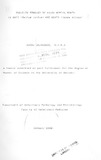| dc.description.abstract | A.iuga remota Benth. (Labiatae or Lamiacea) is a Bmall shrub found in many areas of Kenya. especially where land has been disturbed by human activities. The plant is known to have therapeutic activities. It is used for treatment of abdominal illnesses and toothache in human and blackleg in cattle. This study was undertaken to investigate its aqueous extract effects on animals, particularly pathological effects. Establishment of the mode of toxicity of A.iuga remota Benth was attempted by relating the clinical manifestations to the histopathological lesions in yiyo*.
Weaner rats (Rattus rattus) of Sprague Rowley breed and goats (Capra hircus) were used to study the pathological effects of the toxic principles of A. jreWQts. The whole plant excluding roots were extracted in distilled water by boiling for a few hours, filtered through cotton-wool, number 1 filter paper and then centrifuged ah relative centrifugal force of 2.12x10 ^g. Then the aqueous extract was dehydrated by freese drying to obtain a powder. The powder was reconstituted in distilled water at required percentage. The aqueous extract was then sterilised
121®C for 15 minutes. It was administered Parenterally by subcutaneous route to experimental animals at various doses. Toxicity in rats was wcnitored by keen observation for symptoms, necropsy indings and histopathological study of tissues of
animals that succumbed and those killed at the end of the experiments. Toxicity in goats was studied by objective observation for clinical signs, serum biochemistry and haematological changes. macroscopic and microscopic lesions of goat which died of acute, prolonged toxicity and those sacrificed were recorded. Aqueous extract was found to be non toxic to rate at levels below 1.37 gm/kg body weight.
The lesions seen in rats depended largely on the dosage and duration of administration of extract to animals. Serially quantified doses were injected intraperitoneally into weaner rats to determine LD50. Then rats were observed for toxic effects. The medium lethal dose (LD50) for crude extract was found to be about 5.5 gm/kg of body weight. The rats that received doses much higher than the LD50 showed acute death with congestion, haemorrhages in visceral organs and central nervous tissues. 60% of rats which died of acute toxicity were found with intussusception in small Intestine. Those that received doses below LD5Q had poor growth, loss of condition relative to dosage and took longer time to succumb.
Histological sections from treated rats, were fixed in 10% formalin and stained with hematoxylin and gobin (H&E) revealed marked haemorrhages, cellular degeneration, and necrosis of uriniferoue tubules, hepatocytes and neurons. Oedema and vacuolation were constant findings in brain and liver respectively. Organs concerned with detoxication and excretion of "toxic substances from the body were mostly affected.
Intestines and brain were also to a certain extent involved. Perivascular and porineuronal vacuolation wns marked in brains and spinal cords, while intracytoplasmic vacuolation, pyknosiE and karyolysis were commonly found in hepatocytes. Epithelial cells of proximal tubules showed degeneration and necrosis with hyaline casts in lumina of tubules especially in the cortex. Lungs showed haemorrhages and congestion. Borne portions could be seen with fibrin in the alveolar sacs. The lymphoid tissue follicles were depleted.
Goats administered with a dose of 900 mg/kg of body weight died of acute toxicity within 48 hours. Clinical manifestations included oedematous swelling along the ventral part of the abdomen for a few hours after administration, excitability, partial paralysis of limbs nearest to injection sites for a few hours, uneasiness, raised coats and loss of condition in prolonged treated cases.
Haematologlcal studies indicated a decrease in packed cell volume (PCV), haemoglobin concentration (Hb), red blood cell counts (RBCK total plasma protein (T.P.) by significant fractions, while mean corpuscular volume (MCV) remained unaffected.
Berum biochemical analysis of enzymes revealed slight decrease in levels of lactate dehydrogenase (LDR) blood urea nitrogen (BUN), serum creatinine and alkaline phospbotase. Alanine aminotransferase and aspartate aminotransferase levels in blood of treated animals elevated significantly.
Necropsy conducted on treated animals revealed petechial haemorrhages, congestion of parenchymal organs and central nervous tissues. Prolonged treatment was characterised by hydrothorax and ascites jn goats which received 350 gm/kg body weight. Oedema of the brain was marked. Microscopically, there were marked cerebral haemorrhages, congestion, perivascular and perineuronal vacuolation. Lungs were congested and haemorrhagic. There was marked degeneration of uriniferous tubules, hepatocytes and neurons. Each of these degeneration invariably led to necrosis in their respective organs.
A.iuga romota daily doses of about 1.6 g/'kg of
body weight cause acute toxicity leading to death in rats. Death is likely to be due to extensive
haemorrhages in various organs. A single dose of 900 mg/kg of body weight caused acute death in goats.
AJugfi__remota extract seems to have sympathomimetic
effects which lead to increased peristaltic movement followed by intestinal invagination. Prolonged
administration of low doses leads to degeneration' and necrosis in liver, kidney and central nervous tissues. Extensive haemorrhages and perivascular vacuolation are likely to have been due to increased permeability and endothelial damage by active principles of A.iuga remota Benth.. | |

